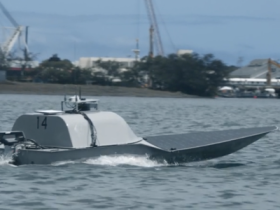THE HAGUE, Netherlands — Airbus unveiled a European-made anti-drone drone concept with elements of autonomy this week, piggybacking on a training dummy design from 20 years ago.
With LOAD — short for Low-Cost Air Defence — the European aerospace giant seeks to address one of the main challenges in modern air defense: the massive cost of intercepting cheap threats.
Executives announced the drone design at an unmanned systems trade show in Bonn, Germany, on March 26. It will be based on a platform from the early 2000s, the Do-DT25, an unmanned aerial system used for target practice. Because of that use case, it was designed to be both cheap and disposable, according to the manufacturer.
The modified UAV will be able to carry three guided missiles. According to Airbus, its operational range will be 100 kilometers or about 160 miles, and it will be launched via catapult. After a successful mission, the drone is designed to return to base and land by parachute, ready to be reused. A prototype with two missiles will fly by the end of the year, the company said, with the final product ready two years from now, by 2027.
While no details have been provided for LOAD specifically, the Do-DT25 on which it is built is 3.1 meters long and has a 2.5-meter wingspan. Its top speed is 300 knots, and it can stay airborne for about an hour.
From Airbus’ promotional materials, it appears that LOAD will somewhat straddle the line between a loitering munition and air combat drone. The UAV will be “supervised from a ground control station,” the company’s press statement reads. It “coordinates the drones on the basis of radar data or air situation images and can therefore autonomously search for, detect and – following the approval of their engagement – combat enemy kamikaze drones.”
For years, experts have raised concerns over growing autonomy in defense and questioned whether provisions to keep a human in the loop when making kill decisions — as Airbus promised in this case — will hold up when push comes to shove.
The autonomous capability promised for LOAD likely builds on Airbus’s previous work with the Do-DT25 platform. In March 2023, the company demonstrated the autonomous guidance and control of several DT-25 drones from an A310 MRTT tanker aircraft, showcasing advances in precise relative navigation, in-flight communication and cooperative control algorithms.
As a further step, Airbus plans to integrate LOAD with other unmanned airborne platforms, such as the company’s Eurodrone project. According to the company, this would allow LOAD to operate in regions “not yet fully covered by ground-based air defense radars.”
In line with Europe’s push to decouple from a dependency on the United States, the new drone contains no U.S. technology, Airbus boasted in its press release. This means it will be ITAR-free, referring to the International Traffic in Arms Regulations imposed by Washington, leaving future export decisions solely to European user nations.
Linus Höller is a Europe correspondent for Defense News. He covers international security and military developments across the continent. Linus holds a degree in journalism, political science and international studies, and is currently pursuing a master’s in nonproliferation and terrorism studies.
Read the full article here





Leave a Reply